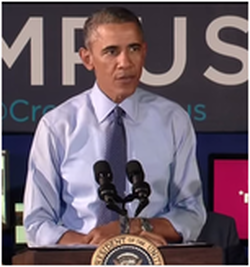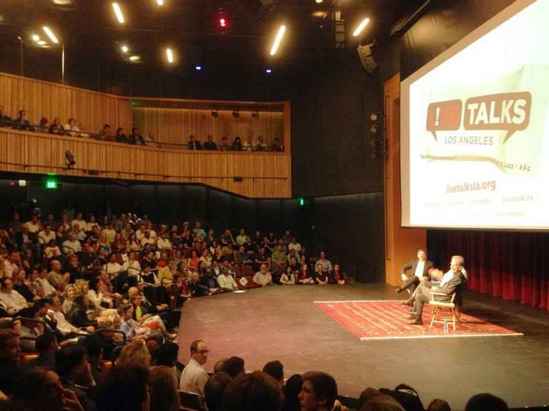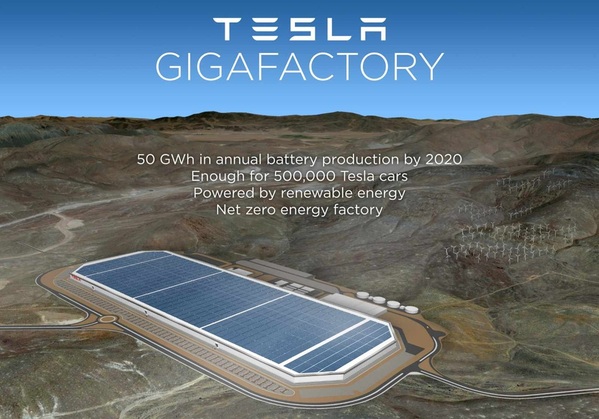|
October 9, 2014: Cross Campus, a tech lab in Santa Monica hosted President Barack Obama and a selected audience of 100 leading Los Angeles based Startup founders, technology entreprenuers, Venture Capital and governmental officials for a tour and a town hall discussion on innovation, startups and the economy for the Millennial generation. http://goo.gl/O2BCcI
0 Comments
Join some of the webs most influential Journalists, Bloggers, Twitter, Pinterest and Instagram users, founders, VCs, CEOs, captains of industry, early adopters, PR execs and more at REACH - The Wearable Future on Thursday, June 26, 2014 from 7:00 PM to 11:00 PM produced by the team of TechZulu and Gadget Review. www.techzulu.com
Google Executive Chairman Eric Schmidt was Google CEO for 10 years. He was joined by Jonathan Rosenberg, advisor to Larry Page, at a panel moderated by Larry Vincent, Chief Branding Officer at UTA. Eric spoke about ‘How Google Works’ with insights into Google’s company culture, HR, and management, and observation about technology, with several valuable takeaways. http://goo.gl/03WHwL
The most monumental demographic shift in history is taking place right now. By the year 2050, the population will increase to 9 billion people while the world’s middle class will increase from 1.5 billion to 4.5 billion. To meet future food demands, global production will have to increase by 70% and applying technology will be the key. www.thriveaccelerator.com
The 5th annual PortTechEXPO featured clean technology demonstrations, interactive displays and the best technology advancements for ports and beyond. Clean technology companies large and small had the chance to connect with business prospects at Southern California's ports and explore opportunities with ports worldwide working to achieve a more sustainable future. www.porttechla.org/expo
Two of the marquee speakers at VatorSplash LA last week were Brian Lee and Jessica Alba 2 of the 4 co-founders of The Honest Company, a eco-friendly family products company. Now that they have stocked their coffers with a raise of $70 million this past summer they told the room of investors and aspiring entrepreneurs at Shutters At The Beach in Santa Monice they have future plans that include international expansion, new products and categories. http://goo.gl/Xzs2rO
After a long and suspenseful five-state fight, Nevada was declared the Giga-winner on Sept. 4, when Tesla Motors announced it had chosen an industrial park east of Reno to be the home of its new, $5 billion electric vehicle battery “Gigafactory.”
State officials and electric car and renewable energy advocates alike celebrated the announcement. Tesla says the factory will provide 6,500 jobs, in addition to some 3,000 construction jobs, a huge boost for a state that’s still mired in the dregs of the recession. It will manufacture batteries for Tesla’s mass-produced, relatively inexpensive sedan, which could help elevate electric vehicles out of novelty status. And perhaps more importantly, the factory will also develop energy storage for the electrical grid that will help smooth out intermittent wind and solar power. Nevada was chosen in part because of the location; it’s a direct shot to the Tesla car factory in California, there’s a lithium mine nearby (for the lithium-ion batteries), and it’s got no corporate income tax. Nevada may have also gotten a leg up on its competitors — New Mexico, California, Texas and Arizona — because it offered a hefty bundle of incentives. Though officials have not released numbers, the Reno Gazette-Journal reports that the incentive package, mostly tax abatements and credits, totals $1.25 billion over two decades. If ultimately approved by the state legislature, it would be the biggest incentive ever offered by the state, by many orders of magnitude. It’s worth it, says Nevada Governor Brian Sandoval, who insists that the factory will have a long-term, $100 billion impact on the state. But critics — from both the right and left — aren’t so sure. The Nevada Policy Research Institute, a conservative group with ties to Charles Koch, says the subsidies are against the Nevada constitution and free-market ideals. In an open letter to Sandoval, NPRI also brings up the right’s favorite renewable energy, subsidy-getting whipping horse, Solyndra, and says Tesla might be headed in the same direction as the failed solar company. Bob Fulkerson, Executive Director of Progressive Leadership Alliance of Nevada (and an HCN board member), expressed concern over the lack of transparency in the incentive negotiation process — other states’ incentive offers remain under wraps, for example. And he questioned the wisdom of such a huge investment in a private corporation rather than in, say, education or infrastructure. In a statement made prior to the announcement, Fulkerson and a host of progressive activists from all five competing states noted: Overspending on Tesla – or any other company – could be a net-loss game in which fewer public resources are then available for investments in areas that benefit all employers, such as education and training, efficient infrastructure, and public safety. All state and local taxes combined equal less than 2 percent of a typical company’s cost structure, but lost tax revenue comes 100 percent out of public budgets. While the Tesla incentives are sizable, they aren’t the biggest Western state and local governments have offered a corporation by any means, according to an incentive database compiled by Good Jobs First. In 1993, New Mexico gave Intel some $645 million in incentives to locate its facilities in Rio Rancho, a suburb of Albuquerque; 11 years later it added another $2 billion (Intel has also gotten big incentives from Oregon and Arizona). Oregon has given Nike over $2 billion in incentives over the years, and Washington has kept Boeing around by giving over $8 billion. Utah hasn’t given any billion-dollar-plus incentives, but has nevertheless been abig and able player in the incentive game, handing out millions to companies that clearly don’t need any help, like Goldman Sachs. Meanwhile, Utah spends less per student on education than any other state in the nation. Colorado doesn't give huge incentives, but does give a lot, primarily to energy companies, including: Northern Colorado Wind, BP, WPX Energy, Encana, Bill Barrett Corp., and Exxon-Mobil. Nevada has been relatively stingy with its incentives, rarely handing out more than $10 million to any single corporation. The exception was Apple, which in 2012 received $89 million in incentives from state and local governments to lure a server/data center to the Reno area. Renewable energy companies have also received similar, albeit far smaller packages from Nevada. It's not easy to quantify the long-term payoff of these gambles. The Apple server center in Nevada provided a lot of construction jobs, but just a few dozen permanent ones -- school districts and mega-resort casinos on the Las Vegas Strip are by far Nevada's biggest employers, bigger even than Tesla will be (but with lower salaries). And over in financially-strapped New Mexico, the $2.6 billion in subsidies to Intel have resulted in 3,500 jobs, making it just the state's 13th biggest employer, outranked by universities, national labs, school districts and health care providers. Of course, the economic impact of a $5 billion, 5 million-square-foot factory goes beyond just the jobs at the plant. If Tesla really employs 6,500 people, and pays them at least $25 per hour, as it promises, that will ripple through the economy as those people buy new homes, shop at local businesses and the like -- the Governor's office expects the factory to increase the state's employment by 2 percent. Under the incentive agreement, Tesla will also contribute $37.5 million in direct payments to public education. And the Gigafactory also is likely to increase Nevada's draw as a headquarters for renewable energy companies, perhaps creating other jobs, and perhaps more customers for the aforementioned lithium mine. So maybe the billions in subsidies make sense. But then, who knows, maybe Tesla would have moved to Nevada for far less money. And Nevada could have used all those incentives to build another school or two. Or hire some teachers: That $1.25 billion could pay the salaries of more than 22,000 Nevada public school teachers. Note: Since this article was first published, the Good Jobs First subsidy tracker has continued to add subsidies to its database. We have updated our chart accordingly as of 9/10. The chart's total for Nevada does not yet include the Tesla incentives because they have yet to be approved by state lawmakers. |
AuthorWrite something about yourself. No need to be fancy, just an overview. Archives
March 2015
Categories
All
|







 RSS Feed
RSS Feed